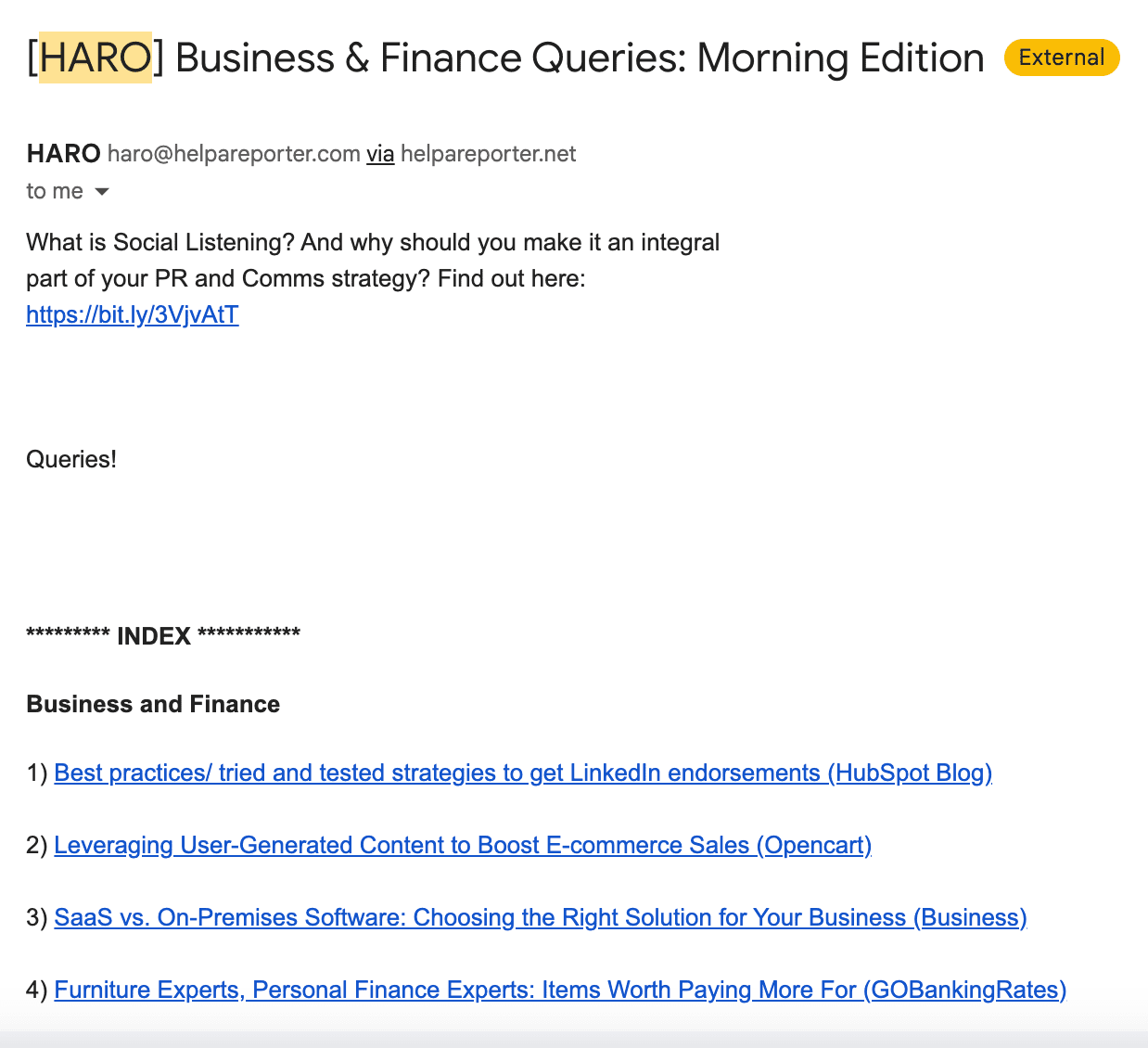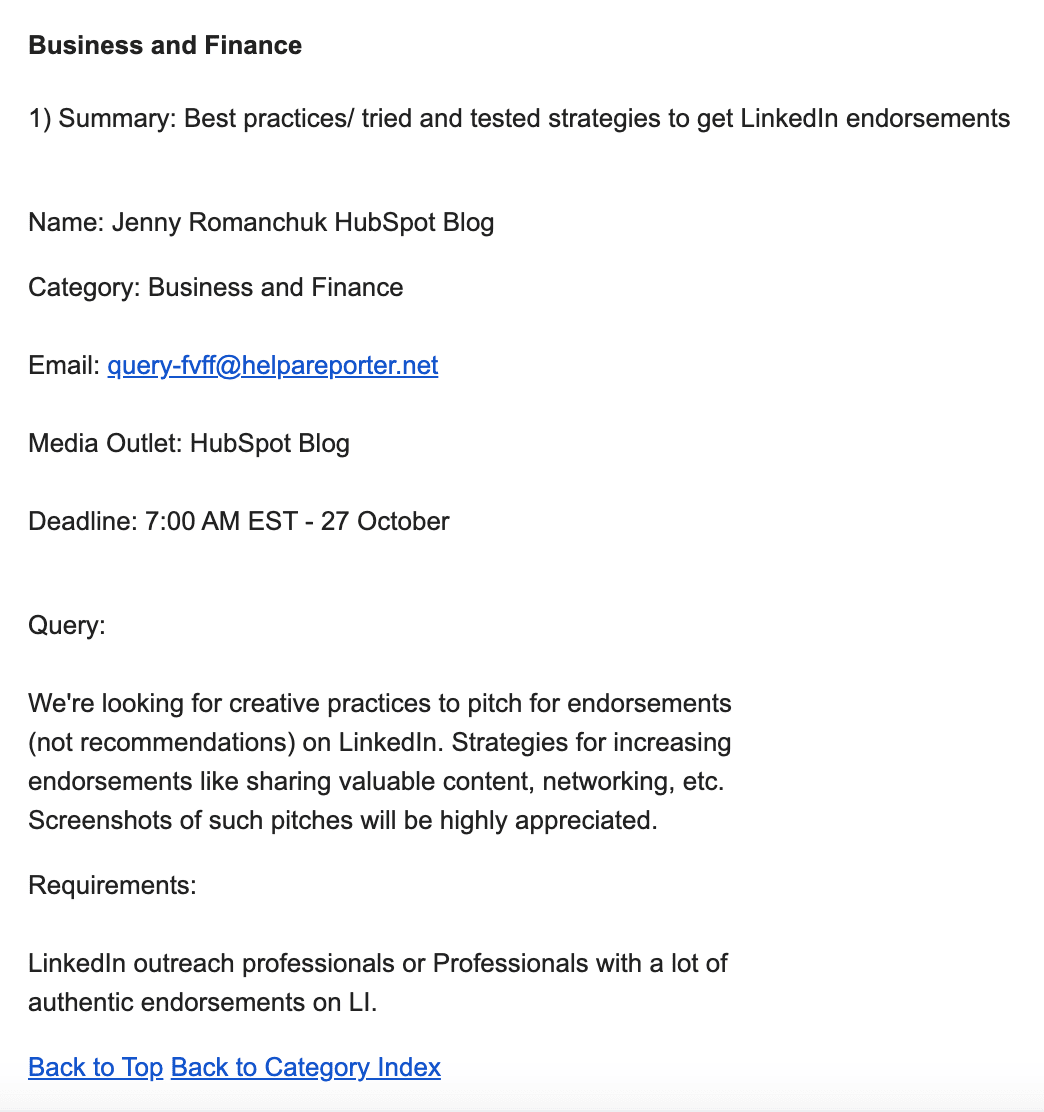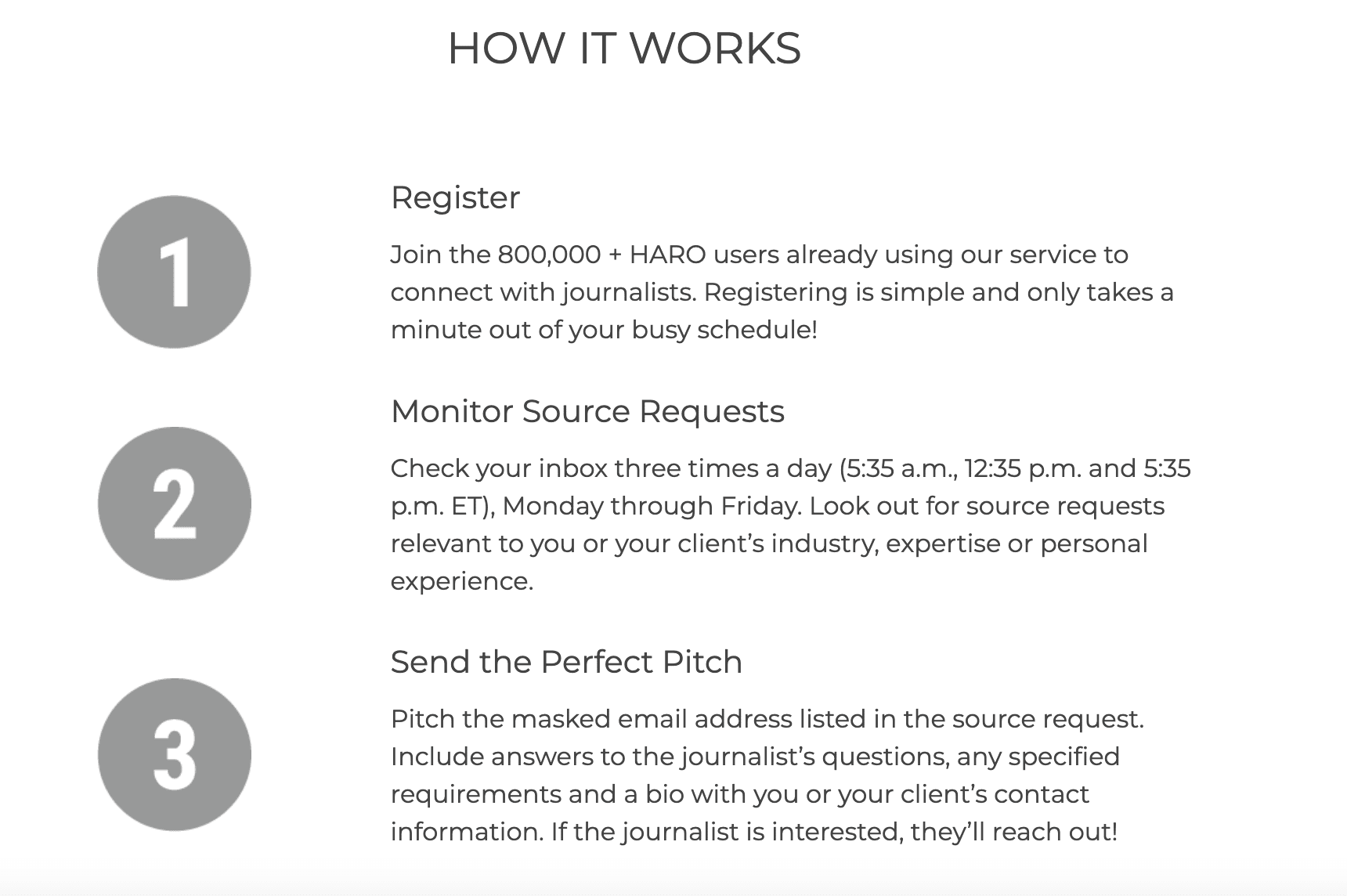HARO Link Building: How to Get High Quality Links the Right Way
- What is HARO?
- How do you use HARO for link building?
- 6 Steps to a perfect HARO response
- 1. Figure out what you're an expert in
- 2. Sign up for a free HARO account
- 3. Put together a quick bio and a headshot
- 4. Send a HARO response that stands out
- 5. Wait & try again
- 6. Be polite and reciprocate
- HARO Link Building FAQs
- Need help with the perfect SEO strategy?
Help a Reporter Out (known as HARO) helps journalists find sources for their stories. But, you don’t have to be a journalist to benefit from this free, powerful resource. You can use it to identify PR opportunities that boost your digital marketing strategy. Thought leadership, social proof, link juice — it’s all at your fingertips with HARO, if you’re willing to put the work in to become a source.
HARO is free, but you need to be strategic with your time to get the most out of it. The return is absolutely worth the investment if you approach it thoughtfully. Here’s how to use HARO for digital marketing and start getting featured as an expert source.

What is HARO?
HARO is a service that allows reporters to find experts to provide quotes or insights into the stories they are covering. It sends emails to a listserv that you can sign up for with queries directly from reporters, newspapers, magazines, and high profile blogs. HARO sends three messages per day — morning, afternoon, and evening — and will send as many emails as categories you selected when you signed up. Here’s an example of what an email looks like from HARO:


Example Emails from HARO
How do you use HARO for link building?
Should a journalist find your contribution fitting, they’ll feature it in their content, often with a backlink to your site, which serves the dual purpose of enhancing your site’s SEO through high-quality, organic links and elevating your brand’s visibility and authority in the public sphere. This symbiotic relationship not only supports journalists in crafting well-informed pieces but also helps brands like yours secure valuable media coverage, driving traffic and building trust with a wider audience.
- Sign up for HARO.
- Search the digests for keywords related to your business and area of expertise.
- Set up an automated email filter or folder for all HARO digests (they send 3 each day).
- Set up headshot & bio.
- Start replying to queries!
- Follow the directions. Double check and make sure you followed the directions.
- Be patient. You’ll respond to dozens of queries before you get picked up.
- Be polite, helpful, and reciprocal.
- Enjoy getting your name out there!
6 Steps to a perfect HARO response
Here are six easy steps you can follow to use HARO perfectly:
1. Figure out what you’re an expert in
HARO is all about journalists finding knowledgeable sources. Are you planning on speaking on the topic of digital marketing? Are you an expert in aromatherapy or teeth whitening? Journalists typically aren’t looking for general response. They want expertise and focus.
Have a good sense of what you can speak to before you start digging into queries or you’ll waste your time. Once you know exactly what topics you can address as an expert source, it’s simple to find relevant queries. Simply search the exact phrase in your email client.
Example: “dog sitting” “HARO”
2. Sign up for a free HARO account
Sign up for a free HARO account as a source. Here’s where things start getting strategic right away. When you sign up for HARO, you will be asked to choose from a few different types of inquires such as “High Tech,” “Business and Finance,” and, of course, “General.” However many you choose, HARO will reach out three times a day. To cut down on clutter, either use a separate email address for this or use an email address with a robust filtering capabilities. (You’re good to go if Google powers your email.)

3. Put together a quick bio and a headshot
Many reporters ask for a headshot, but you can’t send attachments when you reply to HARO queries. So upload a good headshot to your website or to Imgur so you can send a link in your HARO response.
Save a super short bio (100 words or less) and a longer bio (no more than a paragraph) somewhere you can easily access them, like Google Drive. Yes, you have to write a bio. And yes, everyone hates writing bios. At least this way, you only need to do it once or twice. Stick to work-related accomplishments, establish why you’re an expert, and keep it simple. Now isn’t the time to be clever.
4. Send a HARO response that stands out
Check HARO digests (by searching in your email client, or if you’re a glutton for punishment, reading the entire email) as often as you can to make sure you jump on queries quickly. Reporters get hammered with dozens, if not hundreds, of responses. You want to get in early and provide exactly what they need.
Read carefully and be specific in your response
To write a great response to a HARO request, carefully select queries that align with your expertise or your business niche to respond to, ensuring that your replies are thorough, tailored, and valuable, highlighting your unique perspective or insights. This isn’t the stage to self-promote, but rather to provide substantive responses, thereby positioning yourself or your brand as a credible authority.
Journalists typically aren’t looking for general response. They want expertise and focus.
Read the request carefully and think about whether you are the right expert to answer the question. In your response, make sure to
- Be friendly; introduce yourself and provide your credentials
- Give a clear, direct, and succinct response to the question
- Include compelling examples or specific instances
- Think about how your response will appear digitally or in print based on the query
- Include contact information so the reporter can follow up as needed
5. Wait & try again
HARO is a highly selective service, which means you can expect it to take a while for you to land your first quote or link. Earning one link will take a lot of time and effort, though luckily, earning even one high quality backlink per month is a solid gain for your website.
You’ll get deleted if you forget something the journalist asked for, or if you provide a response that’s too long or too short. Most prefer not to have to follow up with you again. So make it count. The more often you respond, the more you can put together a library of common responses that you can lightly edit next time.
And don’t expect to hear back if the journalist isn’t interested. In fact, you might not hear back even if the journalist uses your information. So set up a Google Alert for your name and your business to be on the safe side.
6. Be polite and reciprocate
If your response is chosen and you’re interviewed or quoted in an article, be sure to share it on your social networks. Most journalists will reach out with a link, and many will give you social-ready language that makes it simple to copy and paste right into LinkedIn. Not only is it good karma to share, it could open the door to an ongoing relationship. Journalists love fast, polite sources and they’ll turn to you again and again if you help them do their job more easily.
You can also ask that the journalist tag you in any posts from the publication where you’re featured. They don’t always have control over social promotion, but it’s worth checking.
HARO Link Building FAQs
Does Google allow buying backlinks?
Google strongly discourages websites from buying backlinks, and they strongly encourage natural link building instead. Natural link building involves acquiring links naturally over time by producing quality content, having a robust digital PR strategy, and using resources like HARO to acquire high quality links by creating helpful content that adds value for users.
Do backlinks matter in 2024?
Backlinks are not as important a ranking factor as they were in previous years. They are not a top three ranking factor, according to a recent statement from Google. Toxic backlinks are also no longer a concern in most cases, and most websites probably do not need to disavow low quality backlinks anymore. But still, backlinks remain an important indicator of site quality, and they are worth incorporating into a broader digital PR and off-page SEO strategy.
Need help with the perfect SEO strategy?
SEO pays off for your brand and your website as a whole, but it’s also a huge undertaking. Not ready to dive into SEO yourself? Or just looking for an outside expert to help guide your plan? Check out what we do and let’s chat.

